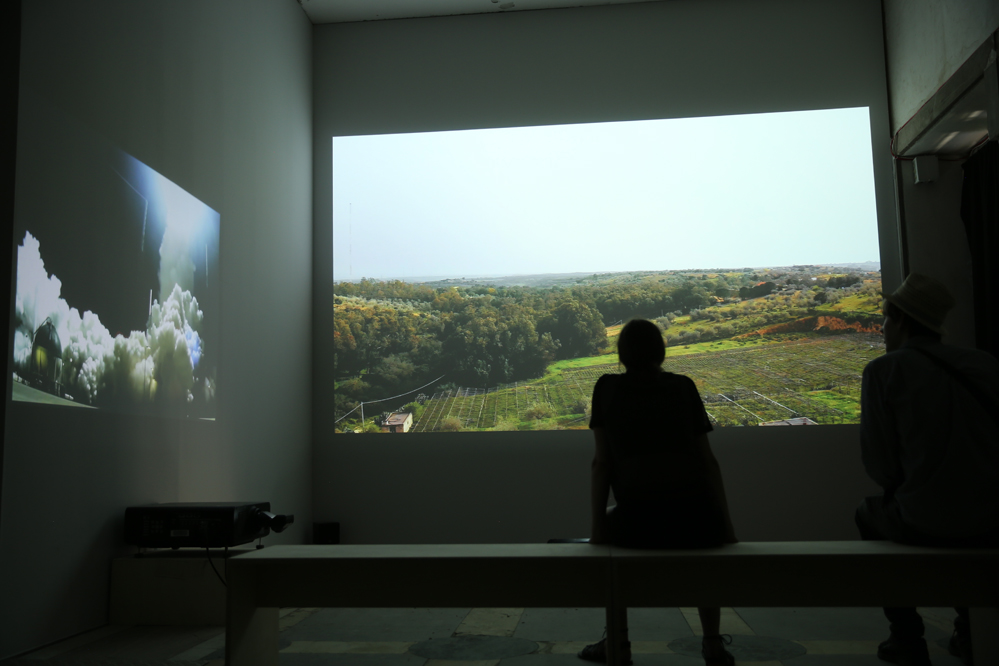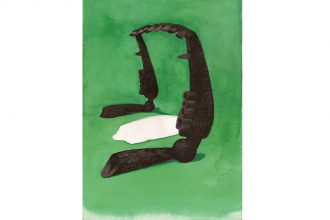On the second day of Manifesta I’m flat on a bench amidst the splendor of Palermo’s Botanical Garden, head resting on my biennial tote bag, eyes stretching into the branches of the giant rubber tree above me. “Stendhal Syndrome?” a passerby with an identical tote jokingly asks. “Something like that,” I reply, but I’ve since reconsidered. No, actually.
Stendhal Syndrome names the state of becoming overwhelmed with the emotional resonance of Renaissance masterpieces, to the point of severe exhaustion, or even fainting. Exhaustion is a familiar sensation to visitors of large-scale exhibitions, but it’s not controversial to say that it has little to do with emotions or beauty. It often begins with the list of fifteen-plus exhibition venues and thirty-plus artists, and continues steadily with the realization that two thirds of the works are videos. As far as such exhibitions go, Manifesta 12: The Planetary Garden. Cultivating Coexistence is no exception.
During my ten days in Palermo, I had time to fall in and out of love with the biennial: to quarrel and make up. Upon returning home, however, and being released from the fritto misto grip of magic Sicily, not many of these highs and lows stuck with me. Like a summer romance, or gelato inside a brioche (an improbable Palermitan specialty), I was back in pasty Germany finding my art experience rather flat; it had not traveled well.
“Don’t get me wrong,” a Milanese friend told me over dinner, between complaints over the languor of Sicilian service, “I’m incredibly affected by the works at Palazzo Forcella, but are journalists not doing their jobs? Why are these documentaries here, and not on [European public television channel] Arte?” Her point was that the biennial context wasn’t doing them any favors. Palazzo Forcella de Seta, a fantastic seaside palace decorated in the Moorish style, houses seven works, all videos, addressing themes from American military surveillance in Sicily (Laura Poitras), to the post-colonial body (Kader Attia and Patricia Kaersenhout), and the ongoing humanitarian crisis of refugees in Europe (Forensic Oceanography, The Peng! Collective, John Gerrard, and Erkan Özgen). Seen as part of an exhibition, it’s tempting to judge these works art-critically by their relationship to the space and to their own medium, their physical properties, their formal composition. But most of these works – exempting those of Forensic Oceanography and John Gerrard – are not prepared for art criticism.
The Peng! Collective, for instance, unselfconsciously adopted the aesthetic of an NGO-infomercial. Thematically, its pieces are urgent and relevant – it’s difficult, in fact, to imagine a more important subject in this place and time – but urgency and relevance alone cannot qualify an artwork. These are the criteria for effective journalism, and as such this chapter of the biennial is better viewed as an information center than an exhibition. The display implodes under the weight of its accumulated didacticism.
“If You’re Just Offering Me Some More Art, You Can Go Somewhere Else” is the title of a 2014 ArtReview article by curator Maria Lind that I’ve thought a lot about since. In it, Lind argues that “quality is about openly supporting and fighting for something – insisting on the fact that this ‘something’ is more important, necessary and/or relevant than anything else” – that is, she defines quality on a scale of conviction, of the exigency of its content. As inspiring as this sentiment was to me at the time of its publication, it now strikes me as the source of my contemporary Stendhal Syndrome: asking art to play outside its strengths – ambiguity, abstraction, self-consciousness – and sacrifice them in the name of a cause. In response to Lind, today, I say: if you’re offering me more documentaries, can you just send me a Vimeo link?
What Palazzo Forcella’s films lack in reflexivity, Taus Makhacheva’s video Baida (2017) tries its best to make up for, one venue over. There, a handheld-camera stares into the bouncing waves of the Venetian lagoon sound-tracked by the plummeting blood-sugar and wayward navigating of two Biennale-goers. “We’re gonna find a nice place to sit, you’re gonna eat something, I’m gonna drink something, then drink some more, and we’re gonna forget about all this.” That familiar tune; a man and a woman have ventured out to sea, looking for an art performance that is seemingly nowhere to be found. “Does he know where it is?” the woman asks about the local steering the boat, “did you show him the catalogue?” The Manifesta catalogue describes Baida as a work about the labor conditions of Dagestani fishermen which “reflects on the precarious nature of human life.” The prank extends from work to meta-text and from Venice to Palermo, as viewers dutifully search for the same socially-engaged thematics as the bewildered subjects of the film. This apt parody does much to relieve the gravity of the content-heavy moorish palace, but simultaneously pulls at the rug beneath it. As much as it helps to laugh at the oft-absurdity of the artworld’s political pretensions, as someone with the ambivalent privilege of belonging to this clique, I do also begin to wonder: who’s all this for, then?
There’s a comeback from self-depletion, however, with Yuri Ancanrani’s film Whipping Zombie (2017), which portrays a commemorative ritual practiced in Haiti, in which the physical violence of slavery is jarringly reenacted for catharsis. The incongruence between the solemn drama of Ancarani’s musical score and the festive elation evident in the accompanying visuals, makes for an intelligent consideration of how collective trauma is processed and redressed. An awkward sidecar to this work, Lapidi (2018), was commissioned by the biennial to respond to the local history of organized crime. However, this series of photographs of tourists taking selfies at sites “made sacred by the blood of the victims that fought the mafia” feels exactly like what it is: a hired gun.
Because the issues so elegantly raised by Ancarani’s earlier film don’t need help finding resonance in Palermo. We are already here, immersed in the city, and the discourse established by the biennial; we are able to connect the dots. As part of its education program, for instance, the Royal Institute of Art in Stockholm’s “Decolonizing Architecture” course was invited to host a two-day symposium concerning the afterlife of Italian fascist-colonial buildings. The event was held inside one such building, the magnificent war memorial Casa del Mutilato, inaugurated by Mussolini in 1936, showing us, much like Whipping Zombie, that past crimes are best addressed in their own language, And again, at Pizzo Sella, the city itself did the work of displaying its scars, as audiences were guided to a scenic viewpoint in the hills some ten kilometers outside of Palermo, to visit an installation by the collective Rotor. Looking out over the mackerel flicker of the Mediterranean is a massive herd of concrete skeletal villas, a luxury housing development stagnated for forty years due to Mafia involvement. With the gloom of a cemetery, the site has been transformed by the sheer presence of a dot on the biennial’s map into a majestic and haunting monument to failed governance and corruption – a brilliant piece of land art.
While I’d say that this counts among the strongest works in the show, it doesn’t really matter whether I saw Rotor’s installation. You get a great view of Pizzo Sella even while swimming at Mondello Beach. The location is everything. The same goes for the city’s old archive, a three-story, mezzanined, space filled with piles of dusty documents dating back to the 1600s, and not usually open to the public. MASBEDO’s video contained within simply could not compete. Back at the botanical garden, too, Michael Wang’s contribution, The Drowned World (2018), presents a staircase offering a view over the wall to an adjacent plot made “inaccessible due to toxicity.” What could have been too easy a conceit, the sight of two massive industrial water tanks – a Becher photograph come to life – burnt itself into the backs of my eyelids; cylindrical elephants imposing on the beautiful garden, testifying to the collateral damage of cultivating nature. Art has always garnered its appeal from the credo that a picture says more than a thousand words, yet here any pictorial mediation is obsolete. Again: location is everything.
To point, simply, to the hill and say: look! – this is how the biennial works its magic; or to open up a building, or frame a group of citrus trees … When I say that nothing stuck with me from Manifesta, it’s not quite true. Palermo stuck with me, with its fascinating, intersecting histories of a thousand years’ migration, fascism, organized crime, but also cultural hybridity, vibrancy, and fabulous dilapidation. In this, Manifesta 12 wins. But between such conceptual sightseeing and the dissemination of valuable geopolitical information through documentary media, it seems that contemporary art has lost.


























1 Comment